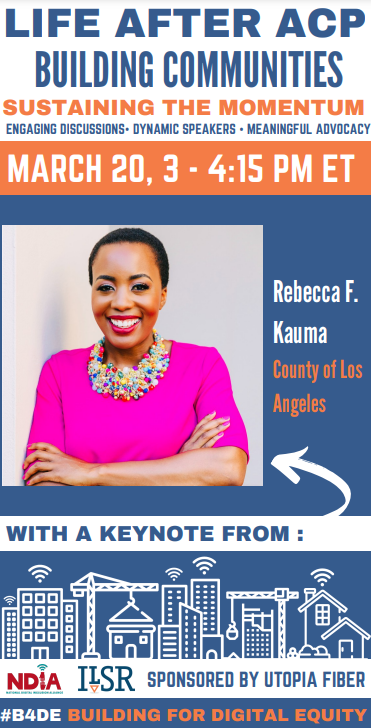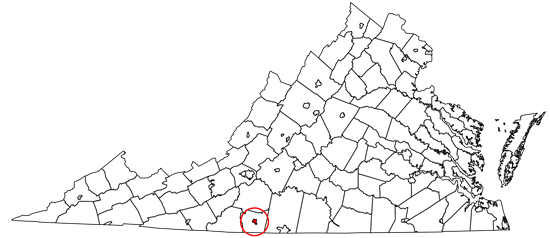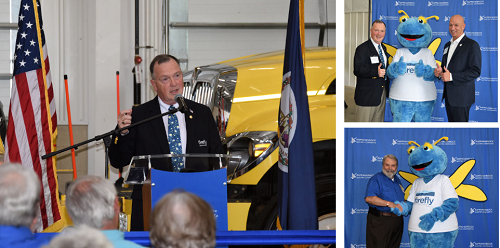
Fast, affordable Internet access for all.

If you missed our most recent Building for Digital Equity Livestream – Life After ACP – the virtual event can still be seen in its entirety (below).
The entire event focused on the imminent end of the Affordable Connectivity Program (ACP) and featured a lineup of speakers who shared on-the-ground perspectives and approaches being adopted at the community level to deal with the broadband affordability crisis in the absence of the popular federal program that has served 23 million Americans since its inception two years ago.
As a bonus, we are sharing links to the speakers slide decks below.
The first of two lightning round speakers, Margaret Käufer – President of The STEM Alliance – gave an overview on the short and long-term work her organization is doing in upstate New York in the face of ACP’s demise. You can find her slide deck here.
The second lightning round presenter Jason Inofuentes – Program Manager for the Broadband Accessibility and Affordability Office in Albemarle County, VA – unveiled an ACP supplement program his office is pursuing and how they see things moving forward. Those slides are here.
The first of the main presenters – Monica Gonzales, Digital Equity Supervisor for Methodist Healthcare Ministries in Texas – gave an overview of what her faith-based nonprofit healthcare organization is doing to address affordable connectivity across the 74 county South Texas region served by MHM. Gonzales’ slides are here.
Today, the first Building for Digital Equity livestream of the year will begin at 3 PM ET. The entire event will zoom in on the imminent end of the Affordable Connectivity Program (ACP) with the lineup of speakers sharing on-the-ground perspectives and approaches being adopted at the community level as they work to keep financially-strapped households connected beyond ACP.
Last minute registration are still being accepted to fill up the last few seats for the virtual gathering here.

Here’s the run-of-show:
NDIA’s Amy Huffman will set the table on where things stand with the ACP wind down process before two lightning rounds take center screen.
For the first lightning round Margaret Käufer, President of The STEM Alliance, will give an overview on the short and long-term community work her organization is doing in upstate New York in the face of ACP’s demise. That will be followed by Jason Inofuentes, Program Manager for the Broadband Accessibility and Affordability Office in Albemarle County, VA, who will spotlight an ACP supplement program his office is pursuing and how they see things moving forward.
Martinsville, Virginia has technically owned a municipal fiber network for the better part of a generation. But the city never had the time, resources, or interest in maximizing the Municipal Internet Network’s (MINet) full potential until COVID demonstrated the importance of affordable access and federal broadband grants made expansion a viable reality.
At a Martinsville city council meeting on February 13, the council offered unanimous support for a phased expansion of the city’s fiber network.
What exactly the expansion will look like, and how it will be funded, very much remain a work in progress.
The core MINet fiber network originally consisted of 48 strands and 20 miles of fiber connecting city schools, municipal buildings, local businesses, and key anchor institutions. A 2009 estimate indicates the network has saved the city between $100,000 and $150,000 annually on telecom lease agreements every year since its inception.

Despite having been first constructed in the 1990s, Martinsville’s MINet only has about 376 customers (98 of them being residential) in a city of nearly 14,000 residents. There’s roughly 20 users currently on a multi-month waiting list, eager to get access to affordable fiber at speeds up to a gigabit per second (Gbps).
Mike Scaffidi has been the MINet director for 26 years. He tells ILSR that while the city has contemplated network expansion for a long time, the city never had the staff or resources to prioritize the expansion or marketing of the city-owned fiber network.
In the quest to unlock billions of dollars in broadband infrastructure money, Louisiana and Virginia have outpaced all other states in the speed with which they are dispatching the BEAD program’s requirements. Louisiana was the first to complete the challenge process and is still the only state to have received approval for Volume 2 of its initial proposal. Virginia, meanwhile, has completed their challenge process but now appears locked in a battle with the NTIA over the low-cost plan parameters they intend to set.
Information is trickling out about the challenge process in both states. We know that Louisiana received a reported 110,00 challenges and Virginia even more, counting 130,000 before the challenge window had even closed. It will be interesting to learn about challengers’ experience with the process, particularly for those nonprofits and local governments which have less experience with broadband mapping and data reporting. In the meantime, the states’ mandatory challenge process disclosures can give us some preliminary insight into how the challenge process is being used.
Two Maps Show Current Status of Challenge Process
NTIA guidance stipulated some transparency requirements for the post-challenge process that we are now beginning to see play out. Louisiana's and Virginia’s maps now show data on the challenges made during the process - who challenged the designation, what type of challenge they made, and, if available, the results of the adjudication process. (NTIA guidance requires “a summary of the challenge” and “a summary of the rebuttal,” which suggests slightly more detail than the maps provide.)
Five years ago, the Central Virginia Electric Cooperative (CVEC) announced the creation of the Firefly Broadband initiative, a subsidiary specifically built to leverage the co-op’s existing electrical assets to deliver affordable fiber to 13 underserved Virginia counties.
Half a decade later, the coop says it has successfully completed its $150 million expansion project, deployed 3,600 miles of new fiber, passed 40,000 total homes and businesses, and directly connected 20,000 state residents–many for the first time ever–in less than 52 months.
“Central Virginia Electric Cooperative partnered with Conexon to perform a feasibility study for a fiber build across their entire service territory – 13 counties and 3600 miles,” CVEC VP of Communications Melissa Gay told ILSR. “Once the target costs, offerings and take rates were determined, we chose to race to secure supplies and labor. Finding great partners has been a tremendous help to the success of our project.”

Buoyed by numerous grants including a $28 million combination loan and grant from the USDA's ReConnect Program, Firefly now provides local residents symmetrical 100 Mbps (megabits per second) fiber for $50 a month, and symmetrical 1 Gbps (gigabit per second) service for $80 a month. There are no contracts and no data caps.
About 90 percent of households connected had no broadband access previously, according to Bruce Maurhoff, Firefly’s senior vice president and chief operating officer.
This morning, the Department of Treasury announced the first round of Capital Projects Fund (CPF) awards to states putting together portfolios to deploy new infrastructure to unserved households. Across Louisiana, New Hampshire, Virginia, and West Virginia, 200,000 locations will see new deployments capable of 100/100 Mbps at a total cost of almost $583 million.
It’s a welcome announcement that should assemble a wide range of solutions and result in much better connections for more than half a million people across the country long left behind by policy and infrastructure solutions so far. It also marks those states which have been more proactive in getting their ducks in a row as early as possible, and opening a dialogue with Treasury about how to use the CPF funds expeditiously to solve remote work, healthcare, and education in the face of the ongoing publish health crisis.
The Basics
The CPF is made up of $10 billion, and part of the $1.9 trillion American Rescue Plan Act passed last year. It complements the $350 billion State and Local Fiscal Recovery Funds (SLFRF) (which can be used for water, sewer, or broadband infrastructure) as well as the Emergency Connectivity Fund (ECF). New infrastructure must be capable of delivering symmetrical speeds of 100 Mbps. There are no local matches required (though most states are and will likely institute some form of requirement).
While it’s been somewhat of a rarity in larger metropolitan areas, the city of Alexandria, Virginia (pop. 158,000) is hoping to bring residents fast, reliable Internet access by building out an institutional network (I-Net) in the state’s seventh largest city.
Construction of the I-Net, which is expected to be completed by February 2025, will connect the city’s schools, public safety buildings and other facilities, and lay the foundation for a city-wide fiber-to-the-home network.
Instead of waiting for Comcast to give residents the service they need, in August the city broke ground on the project that was long in the works. The main aim is to connect government facilities with the hope that the city will lease out the conduit to a private Internet Service Provider (ISP) as a way to incent more broadband competition.
According to the city’s broadband webpage: the “Municipal Fiber project will create potential partnership opportunities to expand consumer choice and increase available speeds for broadband services.” If the city moves forward with a public-private partnership, it could make the municipal network one of the largest in the country.
City officials have created a Request for Proposals (RFP) process, in which they will be looking for ISPs that have a track record of connecting other communities in the state. The winning bidder would then be given a contract to build a fiber network that best serves the public interest, working closely with the city in deploying network infrastructure.
Broadband In the Works
Virginia is one of the 17 states that puts restrictions on municipal networks, mandating that “municipal networks impute private sector costs, pay additional taxes, set excessively high prices, and/or refrain from subsidizing affordable service, in the name of protecting private ‘competition.’” But that hasn’t stopped city officials from finding solutions to the lack of high-speed connectivity in the community.
Across the Commonwealth of Virginia, local governments, county broadband authorities, cooperatives, and private Internet Service Providers are leveraging the influx of American Rescue Plan funds to reach the state’s goal of achieving universal access to high-speed Internet connectivity by 2024.
With $850 million in state appropriations for broadband connectivity and $1.15 billion in local government and private service providers’ funding matches, the state is on track to invest $2 billion dollars toward broadband expansion in the coming years, and is currently investing in broadband expansion projects at record levels.
In August, Gov. Ralph Northam and the Virginia State Legislature agreed to devote $700 million of the state’s $4.3 billion in American Rescue Plan funds to expand access to broadband. The $850 million investment the state has announced will consist mostly of American Rescue Plan aid. The funds will be administered by the Virginia Telecommunication Initiative (VATI), which distributes grants to public-private partnerships to extend broadband service to unserved regions of the state, or areas that lack access to Internet service delivering connection speeds of at least 25/3 Megabits per second (Mbps).
Public-Private Partnerships Deep in the Heart of Virginia
From the marsh grasslands making up Virginia’s Eastern Shore, across the three peninsulas carved out by the Chesapeake Bay, all the way to the Shenandoah Valley in the West, a diverse array of regional partnerships have formed between Virginia’s local governments, electric and telephone cooperatives, and private ISPs as broadband expansion efforts continue to advance in 2022.
With the pandemic-induced rise in remote work, distance learning, e-commerce, and telehealth, a new report published by the Urban Land Institute (ULI), sheds light on how the demand for high-speed Internet connectivity has “helped shift the real estate industry itself from thinking just in terms of physical space to also considering how to engage within a virtual environment.”
The ULI report, Broadband and Real Estate: Understanding the Opportunity, identifies the challenges and opportunities in addressing the digital divide and how real estate professionals and land-use planners can play a central role in designing and deploying broadband networks to meet the growing connectivity needs of communities everywhere.
The report explores four instances when community planners placed technology at the forefront of their development projects and details the positive impact it had on the projects -- from a neighborhood in Washington that designed its fiber-to-the-home network with an emphasis on sustainable development and energy efficiency, to a business and tech hub in Northern Virginia, whose owner purchased seven blocks of CBRS spectrum in 2020 to accelerate the deployment of 5G in the area, establishing it as a center for innovation.
Broadband and Real Estate [pdf] also provides guidance on how real estate planners and professionals can be pivotal in creating more equitable and competitive Internet access ecosystems. For example, the report recommends owners of multifamily properties, or MDUs, install carrier neutral wiring sets to each unit, so MDU residents always have a choice among broadband service providers. The report states owners of MDUs should own all of the Internet infrastructure in their building themselves, so it is independent and the property can not be monopolized by a single Internet Service Provider (ISP).
Some key takeaways from ULI’s Broadband and Real Estate report are:
With American Rescue Plan funds flowing into state government coffers, about a third of the nation’s 50 states have announced what portion of their Rescue Plan dollars are being devoted to expanding access to high-speed Internet connectivity.
The federal legislation included $350 billion for states to spend on water, sewer, and broadband infrastructure, though everything we have seen suggests that the vast majority of that will not go to broadband. There is also another $10 billion pot of rescue plan funds, called the Capital Projects Fund, that mostly must be used to expand access to broadband.
Laboratories of Broadband-ification
As expected, each state is taking their own approach. California is making a gigantic investment in middle-mile infrastructure and support for local Internet solutions while Maryland is making one of the biggest investments in municipal broadband of any other state in the nation. And although Colorado does not prioritize community-driven initiatives, state lawmakers there have earmarked $20 million for Colorado’s two federally-recognized Indian tribes to deploy broadband infrastructure with another $15 million devoted to boosting telehealth services in the state.
Undoubtedly, individual states’ funding priorities vary. Some states may be relying on previously allocated federal investments to boost broadband initiatives and/or have been persuaded the private sector alone will suffice in solving its connectivity challenges. And in some states, such as Illinois, Minnesota, and Maine, lawmakers have prioritized using state funds to support broadband expansion efforts while other states may be waiting on the infrastructure bill now making its way through Congress before making major broadband funding decisions.
As of this writing, 17 states have earmarked a portion of their Rescue Plan money (totaling about $7.6 billion) to address the digital divide within their borders. Those states are Arizona, Arkansas, California, Colorado, Delaware, Hawaii, Indiana, Kentucky, Maine, Maryland, Montana, Missouri, Virginia, Tennessee, Vermont, Washington, and Wisconsin.